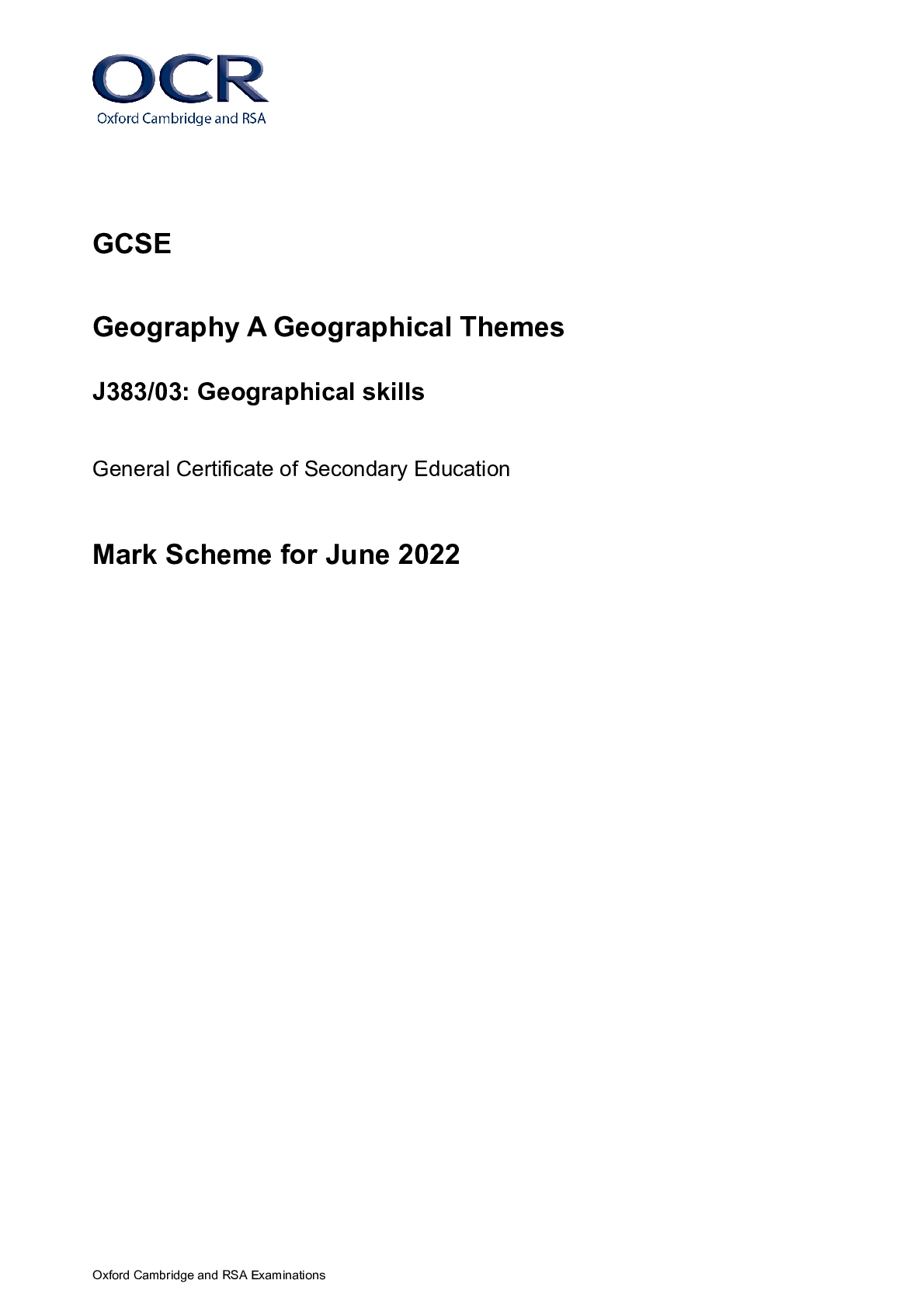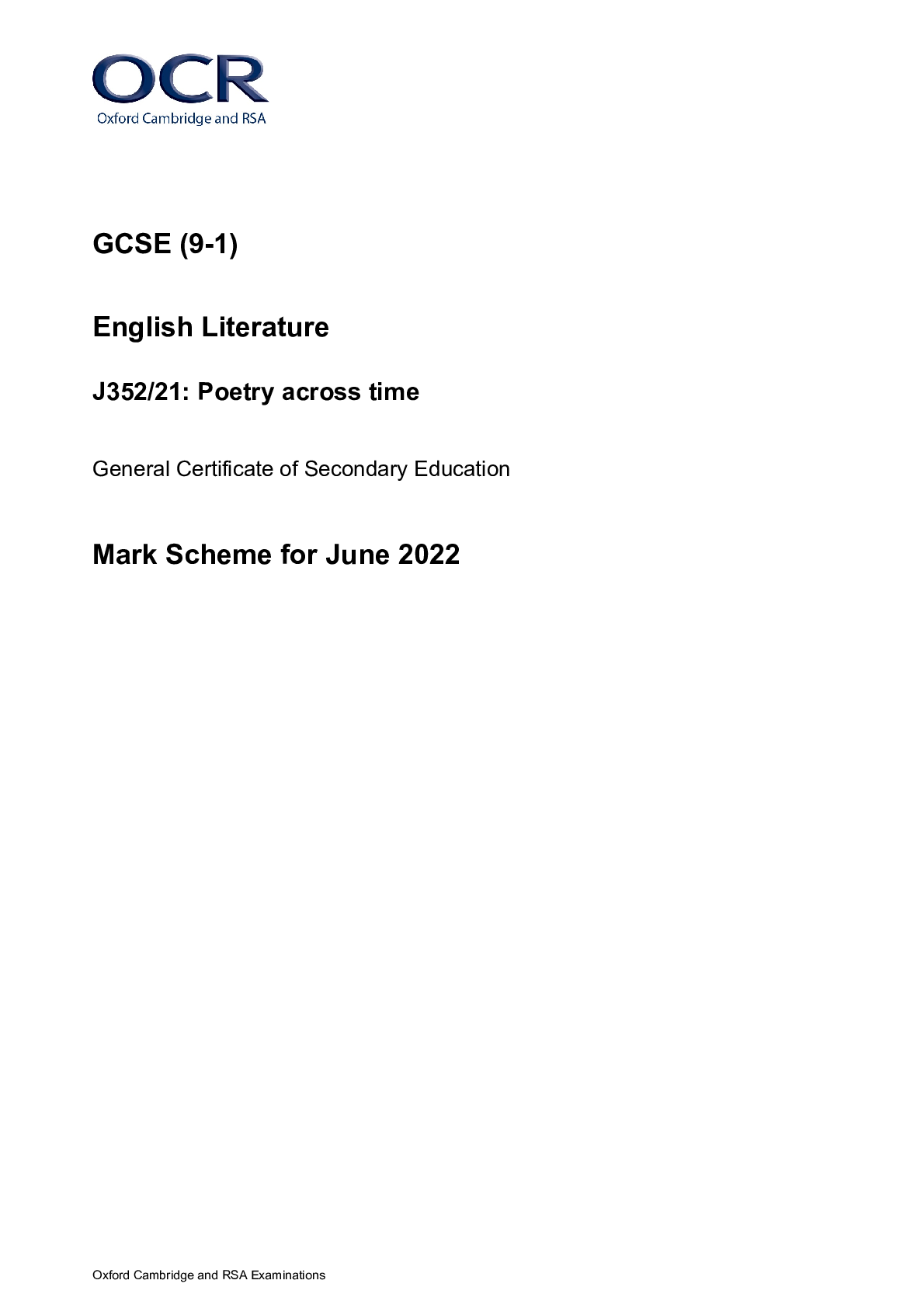Biology > GCSE MARK SCHEME > GCE Biology A H420/03: Unified biology Advanced GCE Mark Scheme for November 2020 (All)
GCE Biology A H420/03: Unified biology Advanced GCE Mark Scheme for November 2020
Document Content and Description Below
GCE Biology A H420/03: Unified biology Advanced GCE Mark Scheme for November 2020 Oxford Cambridge and RSA Examinations GCE Biology A H420/03: Unified biology Advanced GCE Mark Scheme for Novemb... er 2020Oxford Cambridge and RSA Examinations OCR (Oxford Cambridge and RSA) is a leading UK awarding body, providing a wide range of qualifications to meet the needs of candidates of all ages and abilities. OCR qualifications include AS/A Levels, Diplomas, GCSEs, Cambridge Nationals, Cambridge Technicals, Functional Skills, Key Skills, Entry Level qualifications, NVQs and vocational qualifications in areas such as IT, business, languages, teaching/training, administration and secretarial skills. It is also responsible for developing new specifications to meet national requirements and the needs of students and teachers. OCR is a not-for-profit organisation; any surplus made is invested back into the establishment to help towards the development of qualifications and support, which keep pace with the changing needs of today’s society. This mark scheme is published as an aid to teachers and students, to indicate the requirements of the examination. It shows the basis on which marks were awarded by examiners. It does not indicate the details of the discussions which took place at an examiners’ meeting before marking commenced. All examiners are instructed that alternative correct answers and unexpected approaches in candidates’ scripts must be given marks that fairly reflect the relevant knowledge and skills demonstrated. Mark schemes should be read in conjunction with the published question papers and the report on the examination. © OCR 20202 Annotations Annotation Meaning DO NOT ALLOW Answers which are not worthy of credit IGNORE Statements which are irrelevant ALLOW Answers that can be accepted ( ) Words which are not essential to gain credit __ Underlined words must be present in answer to score a mark ECF Error carried forward AW Alternative wording ORA Or reverse argument3H420/03 Mark Scheme November 2020 4 Subject-specific Marking Instructions INTRODUCTION Your first task as an Examiner is to become thoroughly familiar with the material on which the examination depends. This material includes: • the specification, especially the assessment objectives • the question paper • the mark scheme. You should ensure that you have copies of these materials. You should ensure also that you are familiar with the administrative procedures related to the marking process. These are set out in the OCR booklet Instructions for Examiners. If you are examining for the first time, please read carefully Appendix 5 Introduction to Script Marking: Notes for New Examiners. Please ask for help or guidance whenever you need it. Your first point of contact is your Team Leader.H420/03 Mark Scheme November 2020 8 Question Answer Marks AO element Guidance 1 a line drawing with clear continuous lines pelvis, medulla and cortex correctly labelled 2 1.1 2.3 ALLOW a variety of shapes and sizes for the cortex medulla and pelvis (but they must be in the correct positions and clear) ALLOW any orientation of drawing e.g. pelvis on the left DO NOT ALLOW incomplete, overlapping or sketched lines DO NOT ALLOW shading or cross-hatching DO NOT ALLOW ureter or blood vessels shown DO NOT ALLOW if label lines incorrectly drawn (e.g. not straight or have arrowheads) or do not start exactly at the structure being labelled e.g. 2 marks for the answer below: b i (re)absorption / regulation, of (named) ions 1 1.1 Cl- / K+ / Na+ / Ca2+, reabsorption / regulation ALLOW words rather than formula (e.g. ‘potassium ion’ rather than ‘K+’) ALLOW active transport of (named) mineral ions ALLOW (re)absorbs water ALLOW regulation of pH IGNORE ‘changes / adjusts, salt concentrations’ IGNORE ‘creates a steep water potential gradient’ IGNORE term ‘selective’H420/03 Mark Scheme November 2020 9 Question Answer Marks AO element Guidance ii increase(s) surface area for, (re)absorption/active transport has, cotransporters / membrane proteins, for, (re)absorption / active transport, of Na+ / amino acid /glucose 1 max 2.1 iii B AND (because) water, is reabsorbed / removed, earlier in the nephron/AW 1 2.1 ALLOW ‘water has exited by this point’ IGNORE selective reabsorption has already occurred c Please refer to the marking instructions on page 4 of this mark scheme for guidance on how to mark this question. In summary: Read through the whole answer. (Be prepared to recognise and credit unexpected approaches where they show relevance.) Using a ‘best-fit’ approach based on the science content of the answer, first decide which of the level descriptors, Level 1, Level 2 or Level 3, best describes the overall quality of the answer. Then, award the higher or lower mark within the level, according to the Communication Statement (shown in italics): o award the higher mark where the Communication Statement has been met. o award the lower mark where aspects of the Communication Statement have been missed. • The science content determines the level. • The Communication Statement determines the mark within a level.H420/03 Mark Scheme November 2020 10 Level 3 (5-6 marks) Describes with some detail the roles of the nervous and endocrine systems in enabling water reabsorption. It is likely that the role of more than one hormone is included. There is a well-developed line of reasoning which is clear and logically structured. The information presented is relevant and substantiated Level 2 (3-4 marks) Describes how the nervous system and endocrine system enable water reabsorption. There is a line of reasoning with some structure. The information presented is relevant and supported by some evidence. Level 1 (1-2 marks) Describes how the nervous system or endocrine system enables water reabsorption or Outlines the role of both systems in water reabsorption. The information is basic and communicated in an unstructured way. The information is supported by limited evidence and the relationship to the evidence may not be clear. 0 marks No response or no response worthy of credit. 6 1.2 2.5 Indicative scientific points may include (but are not limited to): AO1.2 Demonstrate knowledge and understanding of scientific processes Endocrine system • hypothalamus causes release of ADH from pituitary aldosterone released from adrenal cortex • ADH released from pituitary gland • ADH binds to receptors on the cell membranes of collecting duct cells … • … and this increases permeability to water (regulated by aquaporins) • role of cAMP Nervous system: • hypothalamus is part of nervous system • osmoreceptors in the hypothalamus … • … detect a low water potential in the blood • ADH is produced in the hypothalamus • posterior pituitary is extension of hypothalamus • correct reference to negative feedback AO2.5 Apply knowledge and understanding of scientific processes in a theoretical context. Aldosterone: • sodium ions pumped out of collecting duct cells (into tissue fluid) (and potassium ions pumped in) • lowers water potential in tissue fluid • concentration gradient established • sodium ions reabsorbed from the collecting duct lumen • water diffuses into collecting duct cells / out of lumen via osmosis.H420/03 Mark Scheme November 2020 11 Question Answer Marks AO element Guidance d i Y AND idea of reduces blood volume the most 1 3.2 e.g. ‘the concentration of water in the blood would be reduced more than with the other diuretics’ e.g. ‘more urine is produced’. e.g. ‘less water is reabsorbed into the blood’. ALLOW X AND increases the (blood) potassium ion concentration the most (as increased blood potassium linked to more sodium ion loss in urine and reduction in tension in blood vessel walls) ii X AND idea of does not raise (blood) glucose (concentration) 1 3.2 e.g. ‘has no effect on (blood) glucose’ DO NOT ALLOW ‘raises (blood) glucose the least’ 2 a Source of blood Valve that controls blood flow Destination of blood right ventricle right semilunar valve pulmonary, artery/arteries left atrium left atrioventricular / bicuspid / mitral (valve) left ventricle 2 1.1 IGNORE 'lungs' ALLOW left atrial ventricular (valve)H420/03 Mark Scheme November 2020 12 b blood, leaks / AW, from left to right ventricle (during ventricular systole) (more) oxygenated blood delivered to lungs deoxygenated blood passes into left ventricle (during atrial systole) less oxygenated blood pumped, around the body / to tissues / to cells less oxygen available for (aerobic) respiration / ATP production 4 max 2.1 ALLOW 'oxygenated and deoxygenated blood mix' IGNORE ‘blood between the two ventricles is not separated’ ALLOW ‘less oxygen transported to, the body / tissues / cells’ ALLOW ‘less aerobic respiration takes place’ c (creatine kinase is an) intracellular (enzyme)/AW (presence in the blood indicates) damage to heart (cells / tissue / muscle) 1 max 2.1 e.g. 'creatine kinase should be within cells' d idea that it ensures the same responses to treatment idea that no genetic variation to affect the results idea that no genetic variation so acts as control variable 1 max 2.3 IGNORE ‘improves validity’ unqualified e.g. produces more valid results as no genetic variation’ / ‘reduces effect of genetic variation on results’ IGNORE ‘no genetic variation’ unqualified IGNORE ‘acts as a control variable’ unqualifiedH420/03 Mark Scheme November 2020 13 3 a i Please refer to the marking instructions on page 4 of this mark scheme for guidance on how to mark this question. In summary: Read through the whole answer. (Be prepared to recognise and credit unexpected approaches where they show relevance.) Using a ‘best-fit’ approach based on the science content of the answer, first decide which of the level descriptors, Level 1, Level 2 or Level 3, best describes the overall quality of the answer. Then, award the higher or lower mark within the level, according to the Communication Statement (shown in italics): o award the higher mark where the Communication Statement has been met. o award the lower mark where aspects of the Communication Statement have been missed. • The science content determines the level. • The Communication Statement determines the mark within a level. Level 3 (5-6 marks) Detailed description and linked explanation of results for both tables. There is a well-developed line of reasoning which is clear and logically structured. The information presented is relevant and substantiated. Level 2 (3-4 marks) Describes results for both tables with some explanation of at least one table. There is a line of reasoning with some structure. The information presented is relevant and supported by some evidence. 6 2.3 2.4 3.1 Indicative scientific points may include (but are not limited to): AO2.3 and 2.4 Apply knowledge and understanding of scientific ideas and techniques in a practical context when handling qualitative and quantitative data. Descriptions: Table 3.1: • light increases length and mass of both roots and stems • group A has less growth than group B Table 3.2: • stems grow towards the light (with a few exceptions) • (almost) half the roots grow away from light • some appear unaffected by light or grow towards lightH420/03 Mark Scheme November 2020 14 Level 1 (1-2 marks) Offers some description for both tables or describes and explains one table. The information is basic and communicated in an unstructured way. The information is supported by limited evidence and the relationship to the evidence may not be clear. 0 marks No response or no response worthy of credit. AO3.1 Analyse scientific information to make judgements and reach conclusions Explanations: Table 3.1: • more carbohydrates produced during photosynthesis • light may trigger growth and germination (through phytochromes) Table 3.2: • details of phototropism (e.g. auxins produced in shoot tip moves to side away from light / auxins cause more cell elongation on side away from light) • light allows photosynthesis • positive phototropism in stems • geotropism more important than phototropism in roots • (some) negative phototropism in roots • other reasons for varied data, e.g. conditions not natural / measurement error / shading of stems / stems heavier than roots so tips ii (unpaired) t-test 1 2.8 ALLOW unrelated t-test DO NOT ALLOW paired/related, t-test iii idea of comparing two means 1 3.3H420/03 Mark Scheme November 2020 15 iv 8.10 is greater than 5.99 (at 2 degrees of freedom) (therefore) significant (difference) at (p =) 0.05 not significant at (p =)0.01 (indicates greater than 95% probability that) difference is not due to chance null hypothesis can be rejected (at p = 0.05) 3 max 3.2 ALLOW ECF for mp2 ,4 and 5 if 9.49 or 11.07 value used from table for max 2 marks ALLOW ‘students chi-squared value greater than critical value for 2 degrees of freedom’ ALLOW ‘there is a significant difference between the observed and expected results’ ALLOW ‘less than 5% probability that difference is due to chance’ b NO3- PO43- 2 1.1 ALLOW NH4+ ALLOW H2PO4- c i auxin(s) / IAA 1 1.1 ALLOW cytokinins ii (soil/water) pH / species of plant / age of plant / size of plant / soil type / water availability 1 3.3 IGNORE carbon dioxide concentration / wind movement / humidity ALLOW pre-treatment of seeds d amyloplasts are, dense / heavy binding of amyloplasts with ER releases Ca2+ /AW idea that Ca2+ stimulates growth (factors) the root grows to the side of the, amyloplasts / Ca2+ release 2 max 3.2 ALLOW amyloplasts fall in direction of gravity e.g. ‘contact of amyloplasts with ER releases Ca2+’ ALLOW ’Ca2+causes growth’ ALLOW ‘elongation’ instead of ‘growth’ 4 a i cell division / cytokinesis idea of cell movement 1 max 2.1 ALLOW binary fission / for replication DO NOT ALLOW mitosis e.g. ‘allows flexibility’ / ‘allows it to bend’H420/03 Mark Scheme November 2020 16 ii idea of maintaining cell, shape / structure 1 2.1 ALLOW to change cell shape / provide support iii binds to, actin / cytoskeleton idea that actin might not function correctly 1 max 3.2 e.g. stops muscle contraction / causes paralysis b Advantages idea of less chance of resistance due to fewer years of use OR (slightly) more effective against MRSA / AW OR smaller chance of, nausea / constipation Disadvantages idea of long-term effects less certain (due to being used for only 4 years) OR (much) less effective against Streptococcus OR greater chance of, headache / diarrhoea 2 3.2 ORA for vancomycin IGNORE ref to vomiting IGNORE ref to being less effective against Staphylococcus IGNORE ref to dizziness c i X restriction (endonuclease) Y (DNA) ligase Z electroporation / culture heating / heat shock / calcium salts 3 1.2 ALLOW electric shock ALLOW calcium ions ii (acts as) marker / reporter, gene idea of to indicate which bacteria have taken up the plasmid 1 max 2.5 e.g. ‘can identify transgenic bacteria’H420/03 Mark Scheme November 2020 17 iii 0.00025 or 2.5 x 10-4 2 2.6 FIRST CHECK ON ANSWER LINE If answer = 0.00025 or 2.5 x 10-4 award 2 marks If the answer is incorrect, award one mark for 1/400 = 0.0025 or 2.5 x 10-3 OR 0.0025/1000 = 0.0000025 or 2,5 x 10-6 OR 0.0000025 x 100 (= 0.00025 or 2.5 x 10-4) iv idea of extract DNA from cancerous liver and (named) healthy tissue choose primers for, E coli / β-galactosidase, DNA idea of comparing rate of DNA amplification 2 max 3.4 e.g. ‘compare amount of DNA after 30 cycles of PCR’ v idea of safety of genetic engineering (in bacteria) has been established idea of few animal rights issues to consider 1 max 3.2 e.g. ‘It’s been done for many years without any problems’ / ‘genetic engineering is safe’ e.g. ‘bacteria do not have emotions like animals that can be engineered’ / ‘bacteria do not feel pain’ / ‘bacteria are not conscious’ 5 a stratified (sampling) detail of stratified sampling correct calculation: 40% (in farmland), 20% (in grassland), 40% (in peat bog) OR proportional numbers 3 3.3 3.4 e.g. number of samples in each sector is proportional to the area or implied by correct calculation / random sampling within each sector e.g. 8, 4 and 8 samples b i large heath butterfly 1405 and 1153 bog hoverfly 30 and 20 2 2.8 Answers must be rounded to nearest whole numberH420/03 Mark Scheme November 2020 18 ii idea of Chapman gives a lower estimate / Lincoln gives a higher estimate idea that difference between the estimates is (proportionally), greater for small populations / smaller for large populations 2 3.1 Read as prose ALLOW ECF from bi c preservation because no visitors allowed OR human interference / peat extraction/ tree planting, restricted not preservation / is conservation because the habitat was being managed / example of management described (e.g. water levels raised / ditches blocked) OR the habitat had already been changed / was not the original habitat 2 max 3.2 DO NOT ALLOW no human interferenceH420/03 Mark Scheme November 2020 19 d Name of conservation agreement International agreement Offers payments to farmers who conserve Environmental (Countryside) stewardship scheme Convention on International Trade in Endangered Species Rio Convention on Biological Diversity All correct = 1 or 2 rows correct = 2 1.1 6 a i low pO2 in the placenta idea of O2 transferred from adult to fetal haemoglobin (in the placenta) fetus receives (sufficient) oxygen for respiration maintains O2 concentration gradient 2 max 1.1 ALLOW ‘low oxygen concentration in placenta’ e.g. ‘adult haemoglobin releases oxygen at low pO2, but fetal haemoglobin will pick up oxygen at the same pO2’. ii initial straight line towards 80% and 10 mmHg (from the origin) curved line to 52 mmHg at 100% 2 2.2 ALLOW straight line that stops short of 80% saturation as long as it passes through the 80% and 10 mmHg point if extrapolated or straight line that goes beyond this pointH420/03 Mark Scheme November 2020 20 b idea of habitat is low(er) in oxygen 1 3.1 c (bilirubin is a) metabolic waste product / described as produced, from haem / during (red blood cell) breakdown (bilirubin) removed / AW, from the body 2 1.2 2.5 ALLOW (bilirubin) removed into the digestive system Total 70OCR (Oxford Cambridge and RSA Examinations) The Triangle Building Shaftesbury Road Cambridge CB2 8EA OCR Customer Contact Centre Education and Learning Telephone: 01223 553998 Facsimile: 01223 552627 Email: [email protected] [Show More]
Last updated: 1 year ago
Preview 1 out of 19 pages
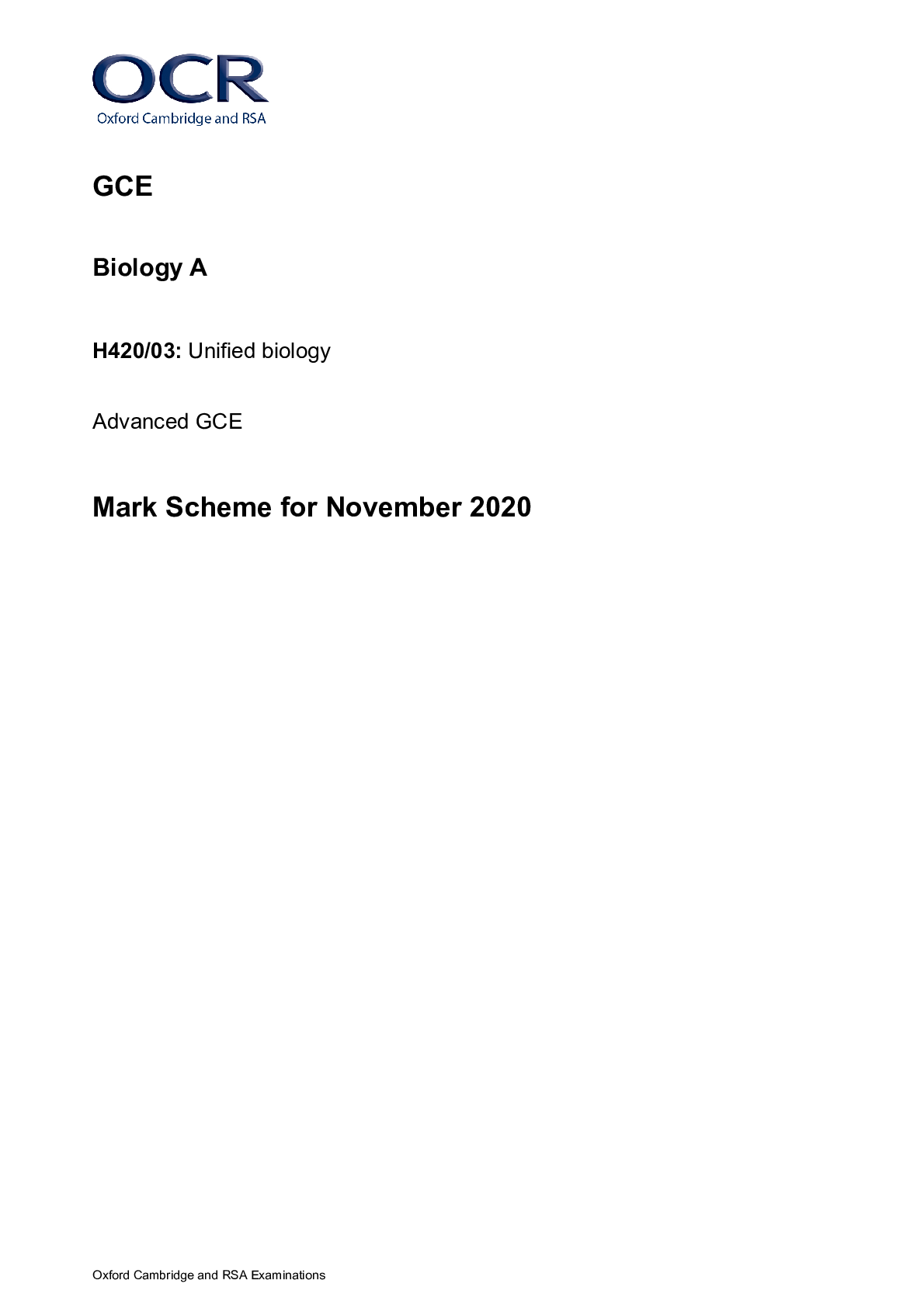
Reviews( 0 )
Document information
Connected school, study & course
About the document
Uploaded On
Oct 07, 2022
Number of pages
19
Written in
Additional information
This document has been written for:
Uploaded
Oct 07, 2022
Downloads
0
Views
30



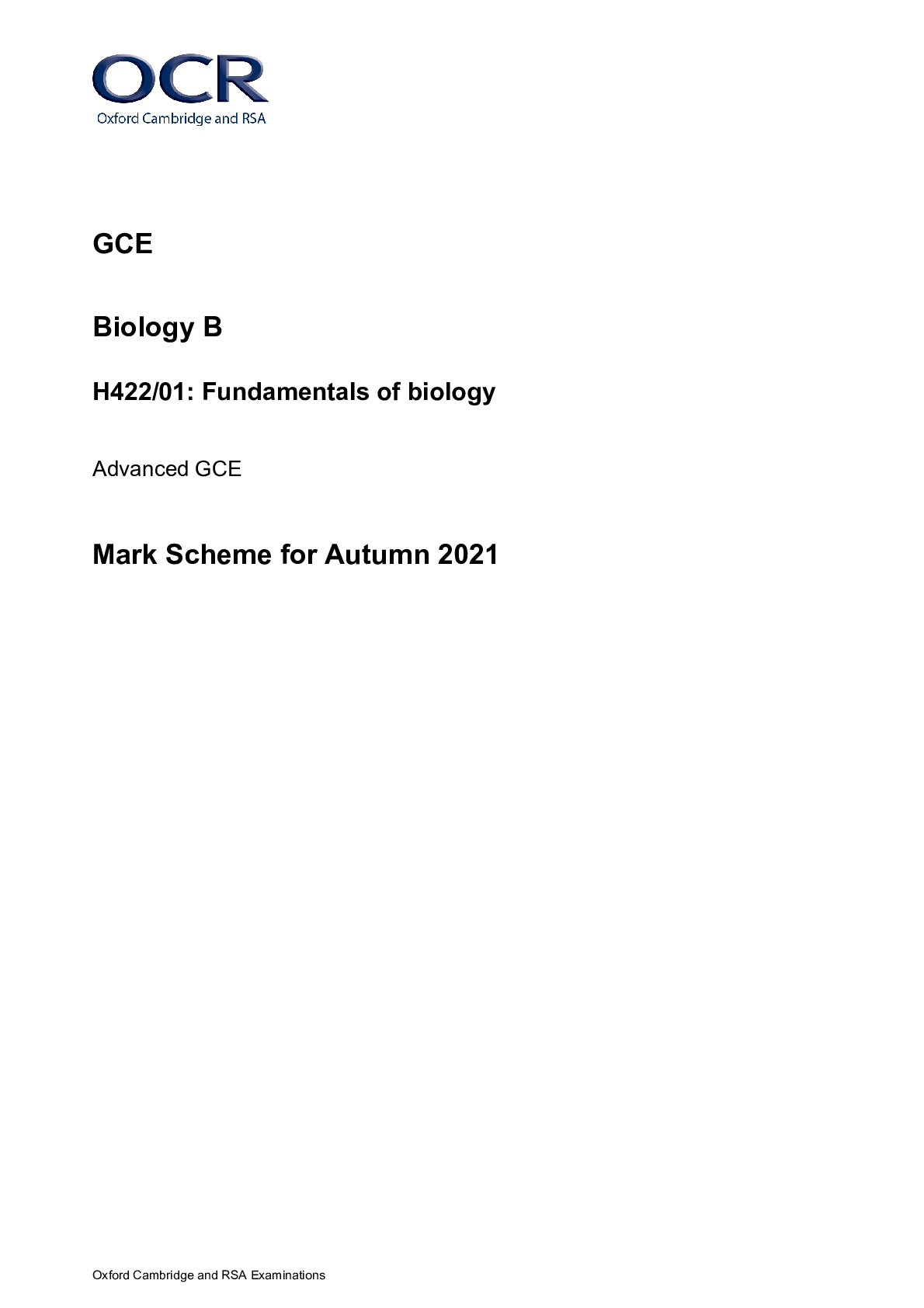
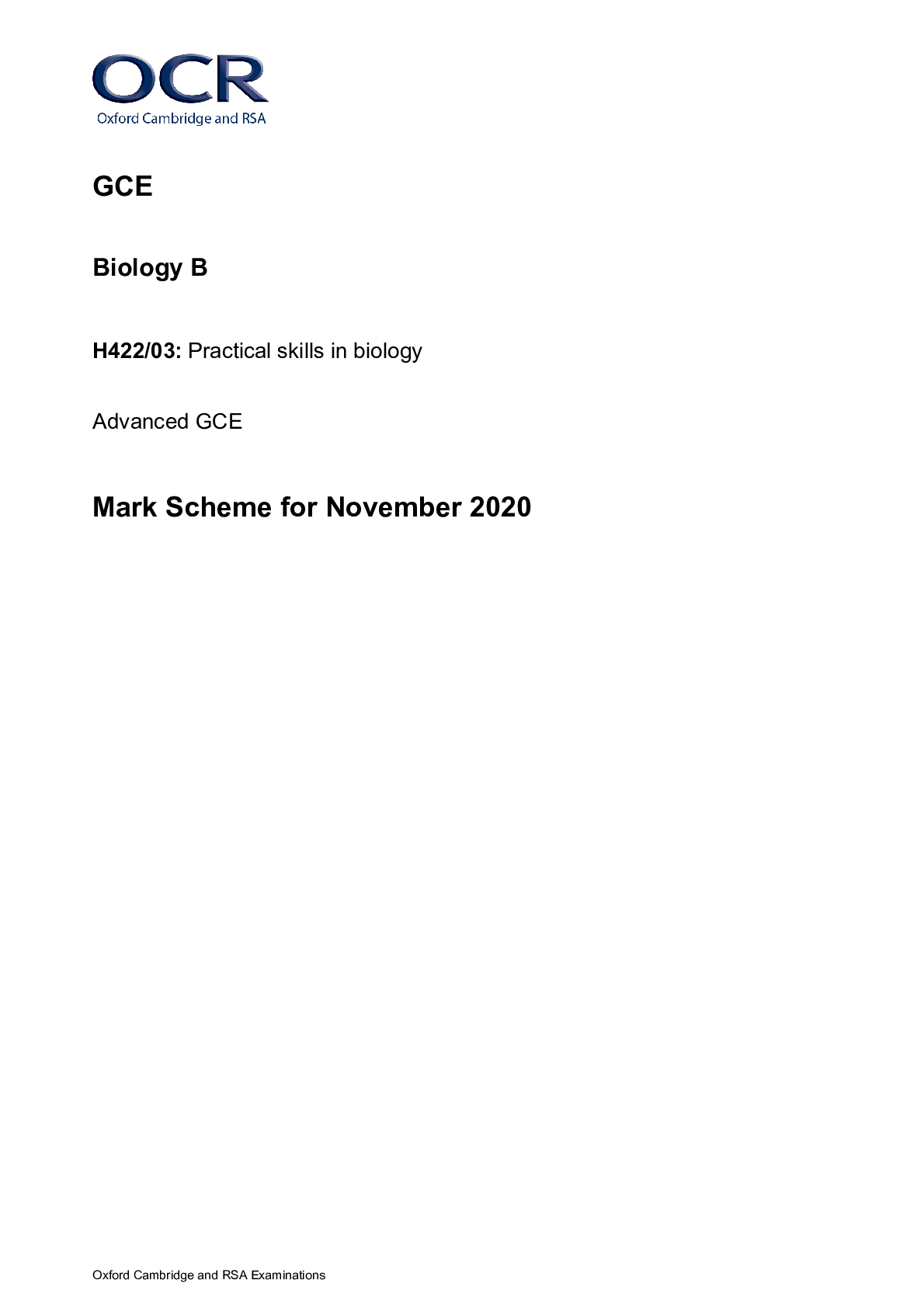
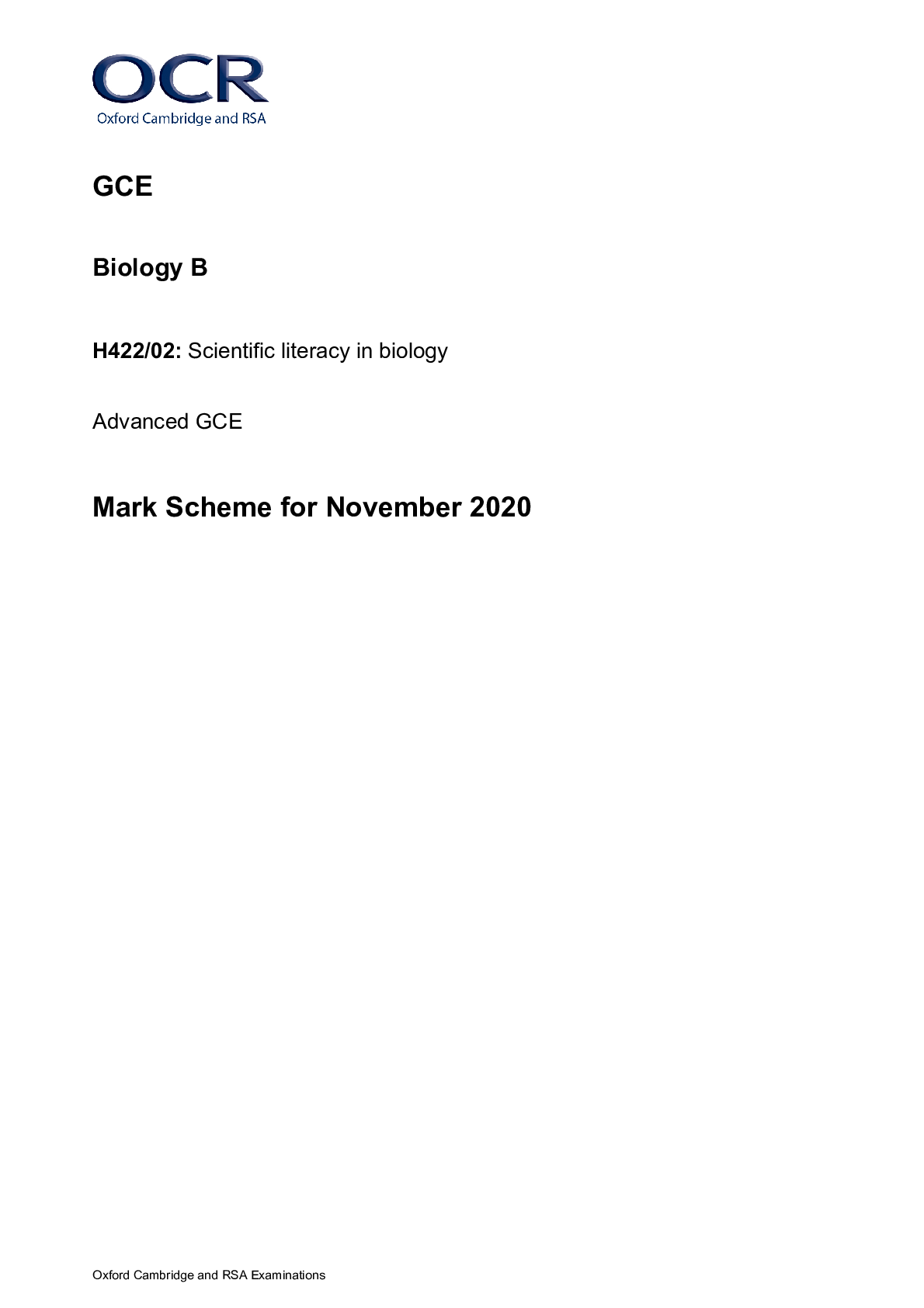
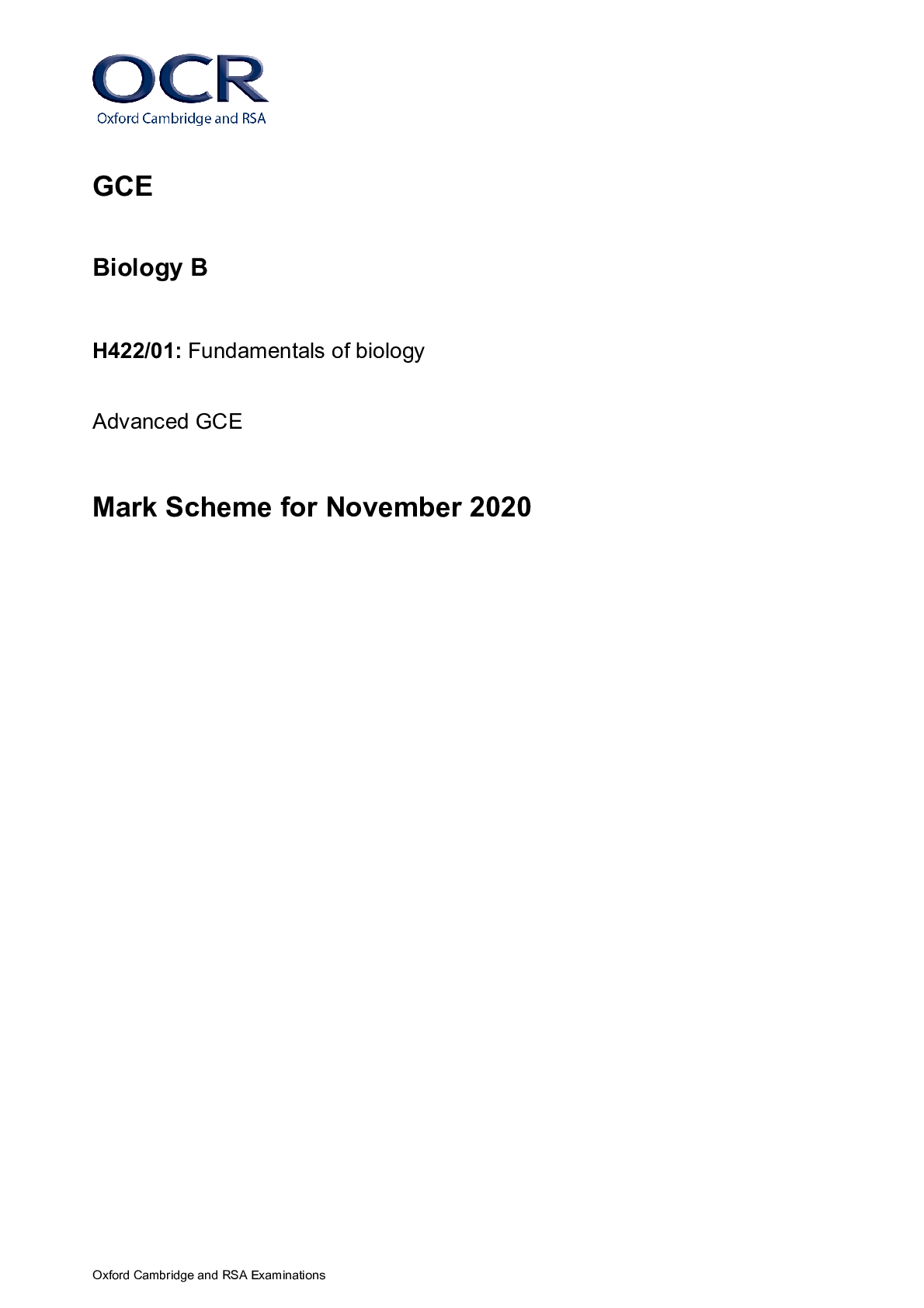

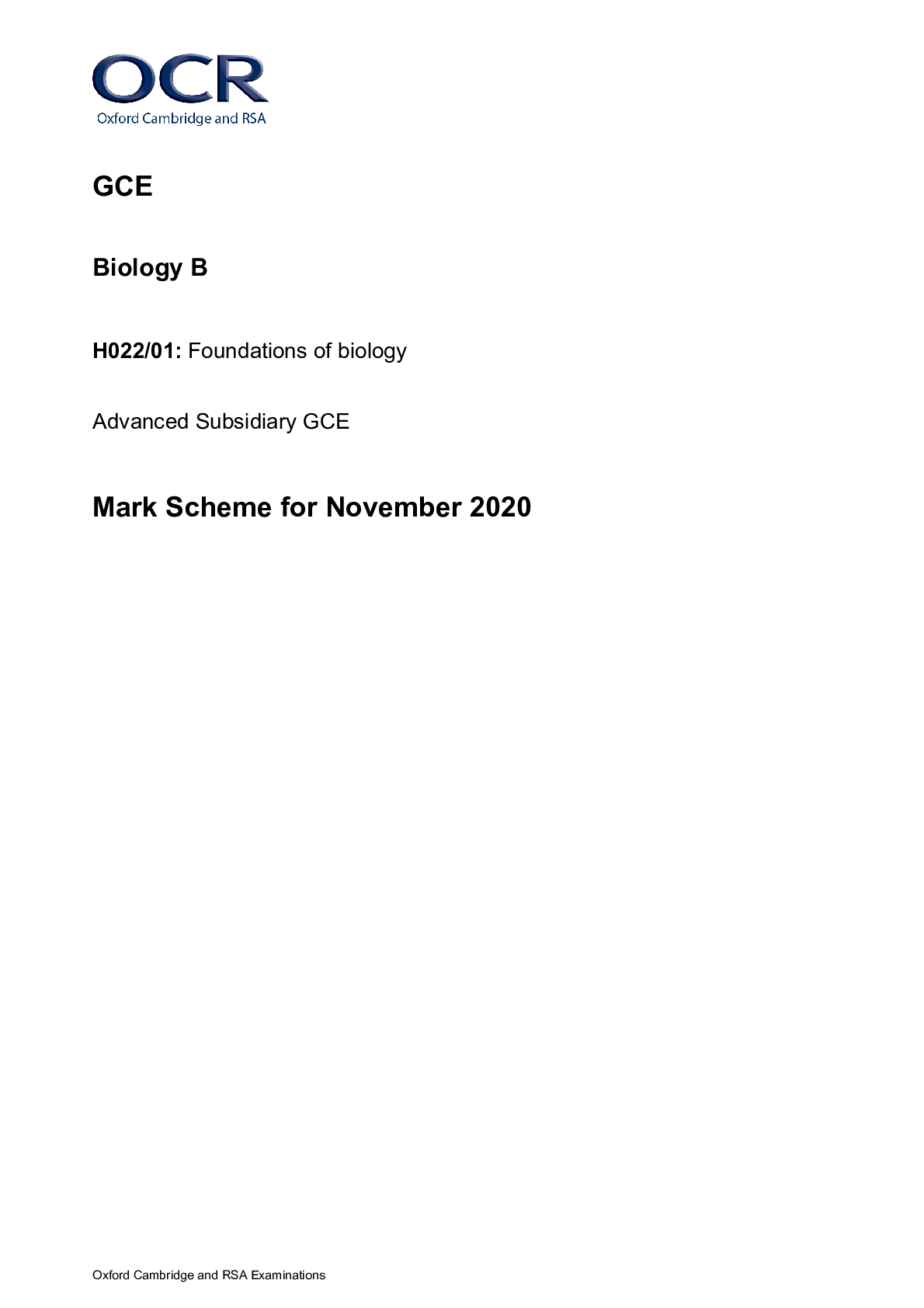
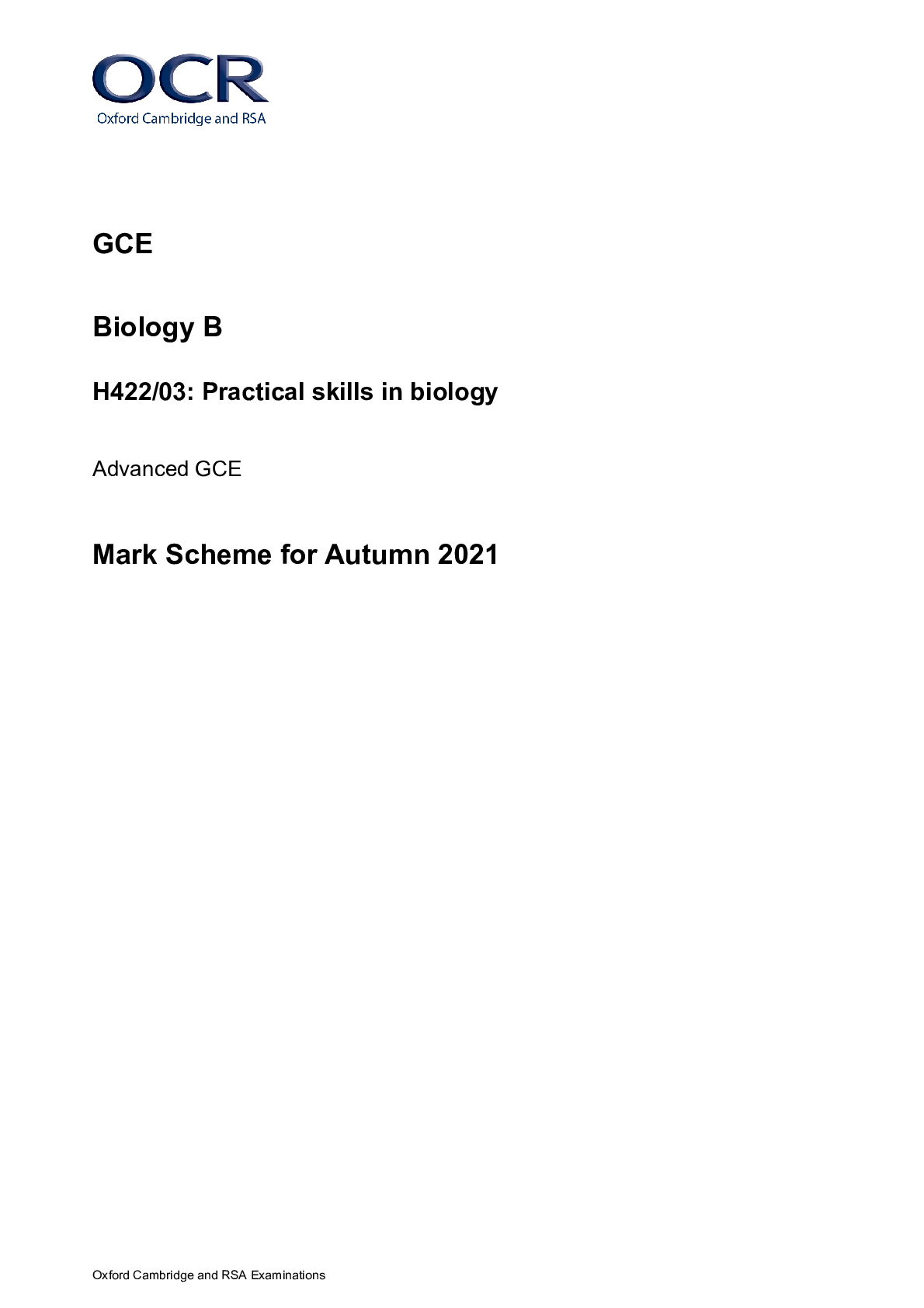
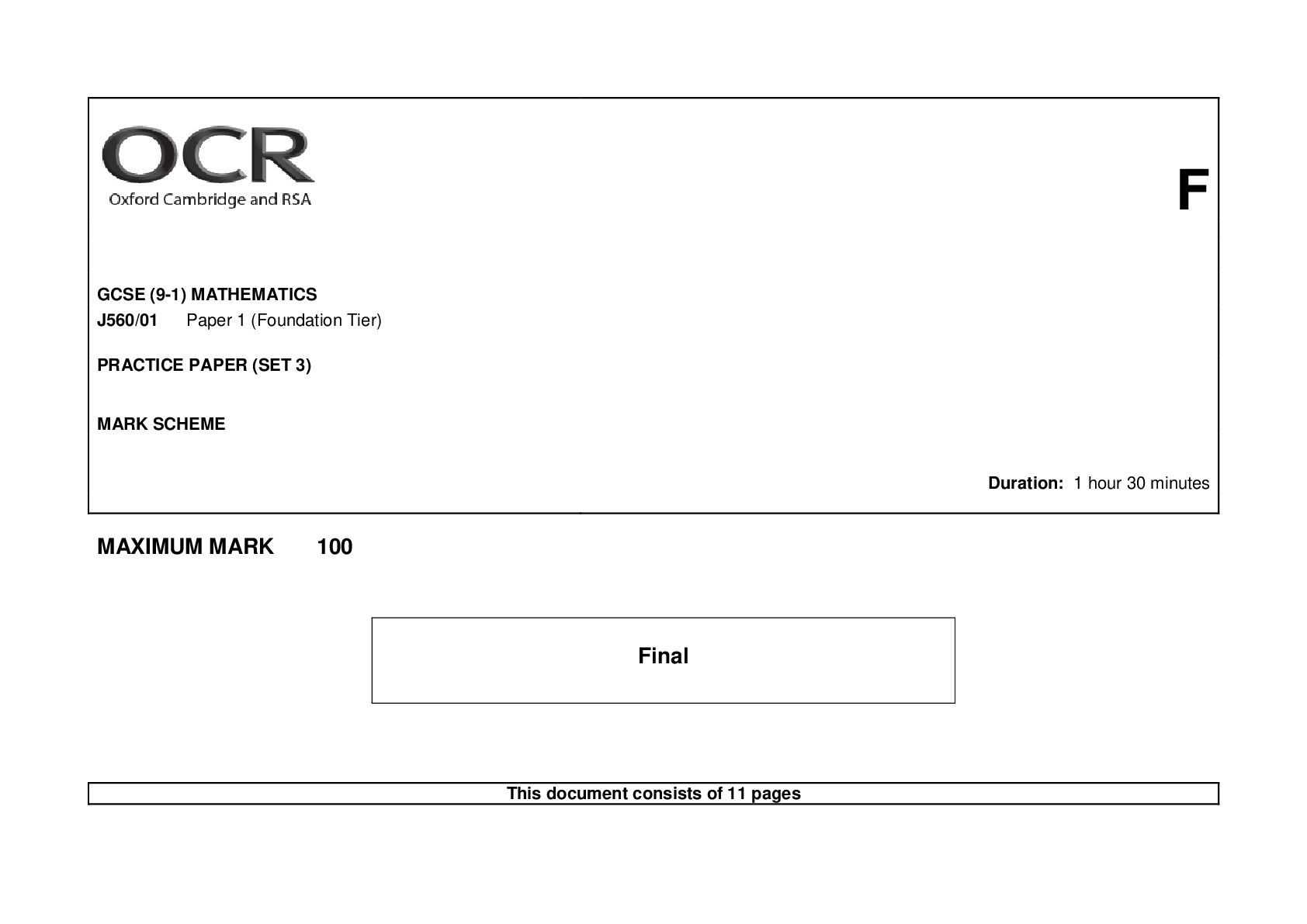
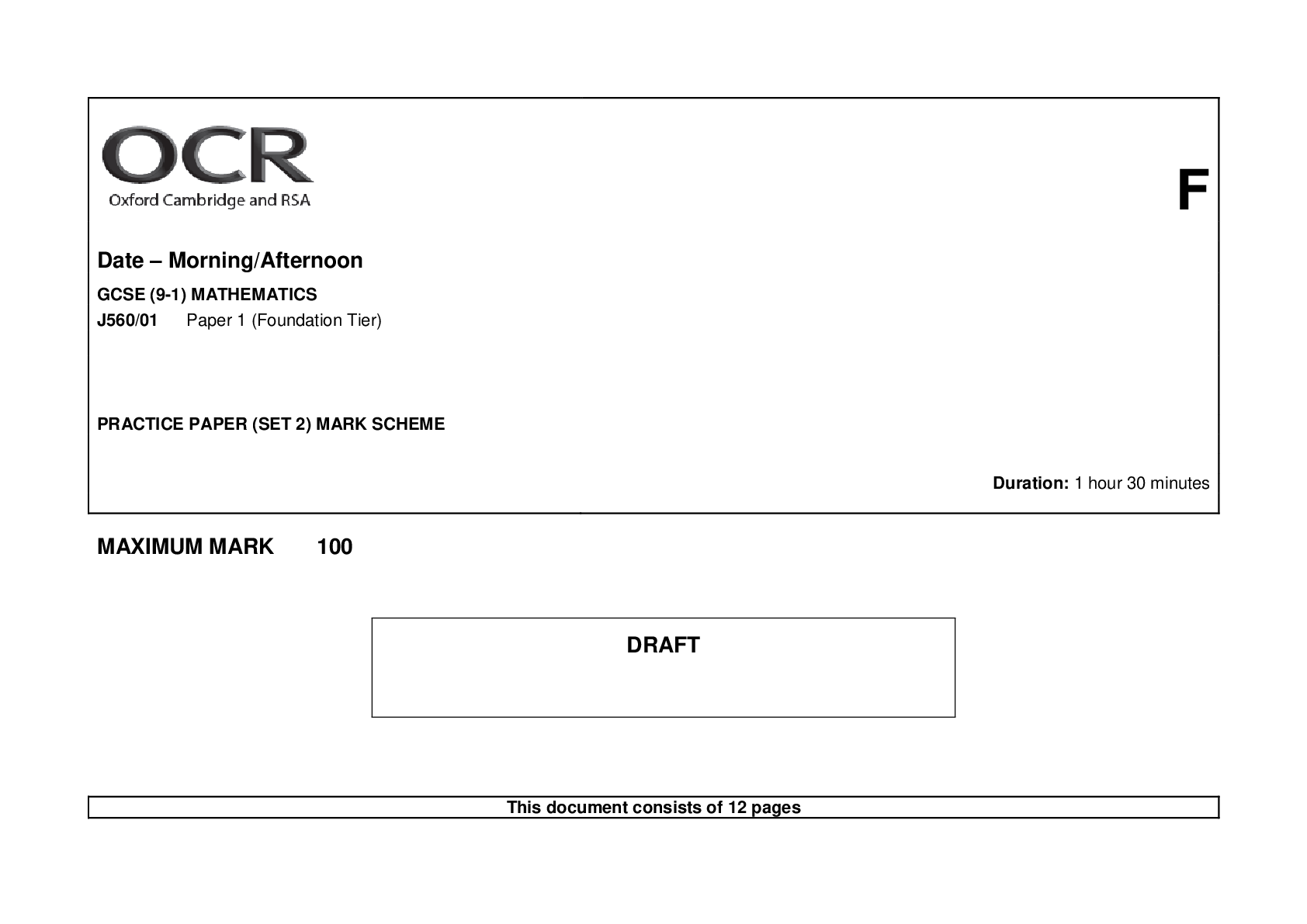
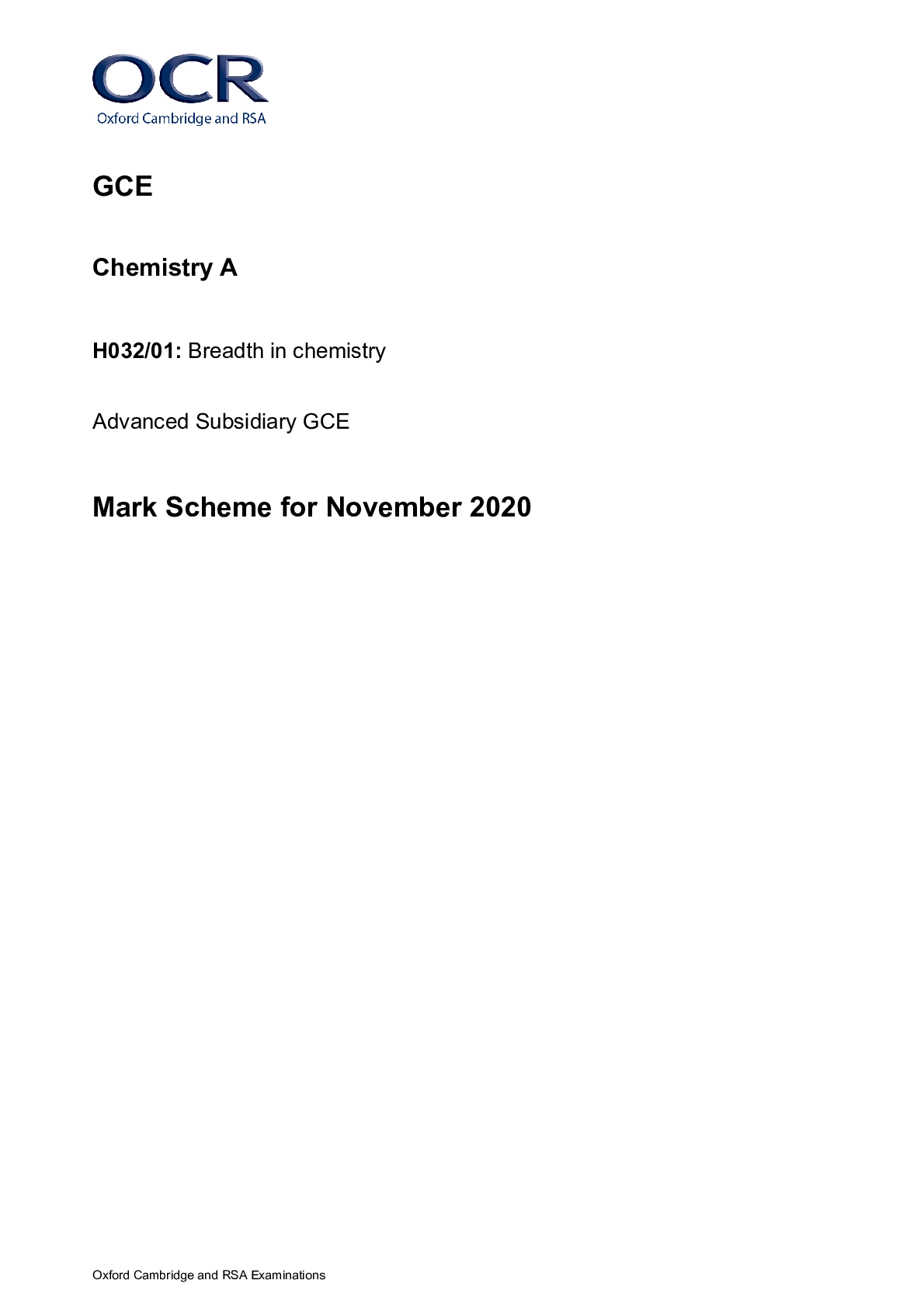

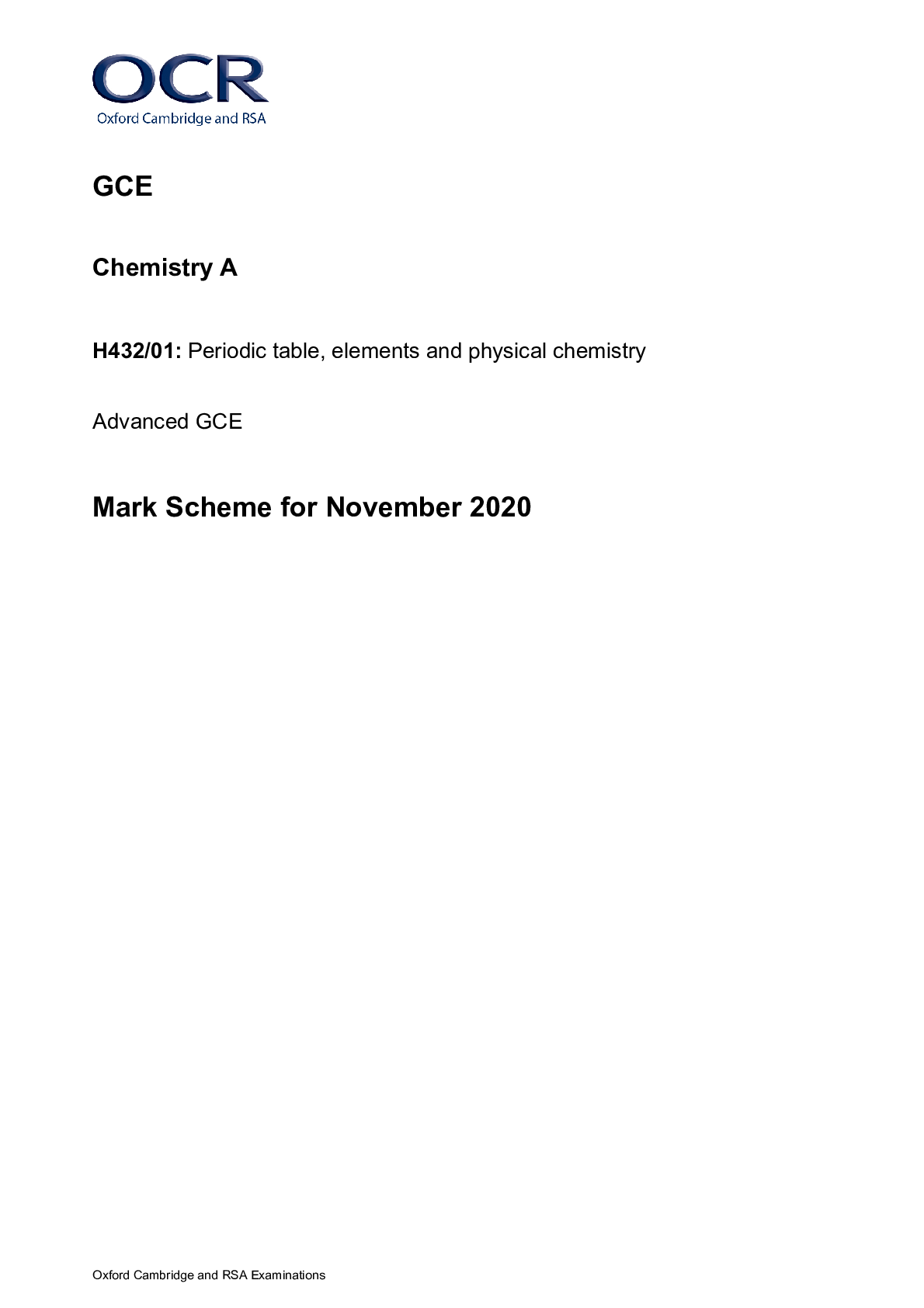
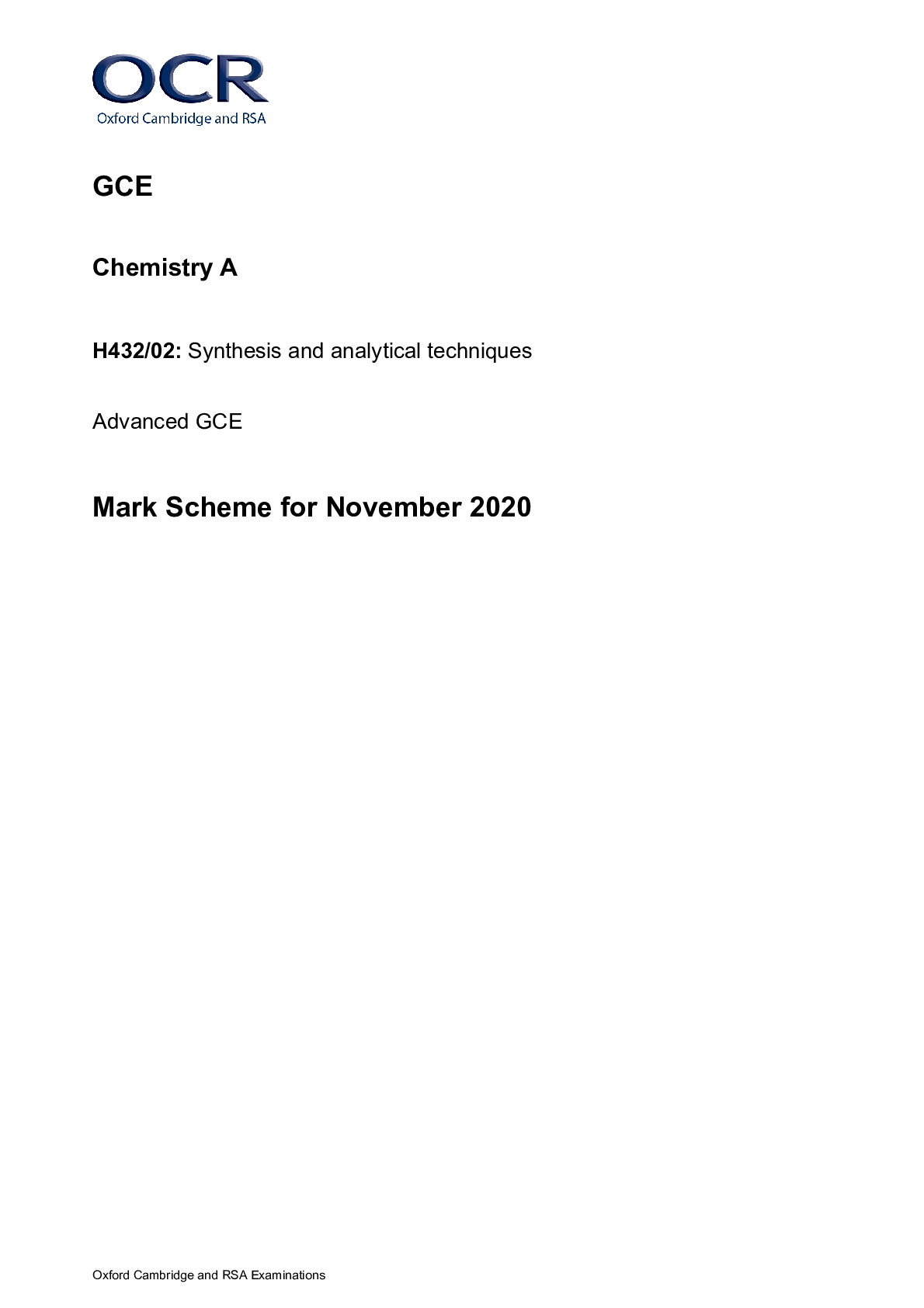

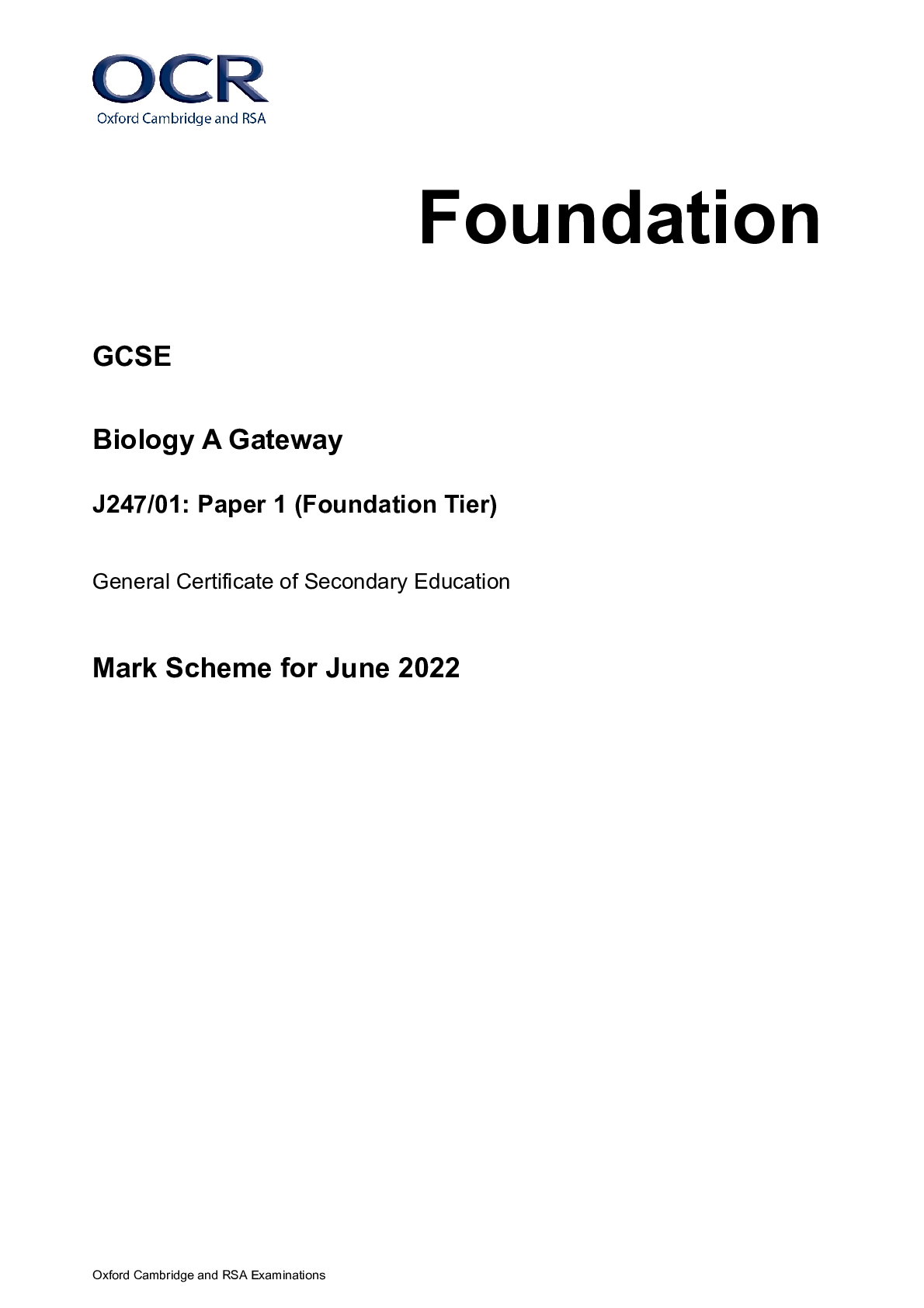
H630-02 Pure Mathematics and Statistics Advanced Subsidiary GCE Mark Scheme for Autumn 2021.png)


.png)

